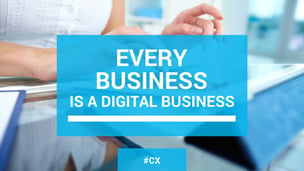What every CIO must know to bridge the customer experience technology gap…

A couple of weeks ago, we published a white paper titled "What Every CIO Must Know to Bridge the Customer Experience Technology Gap.” Unsurprisingly, we reached out to our database and others to let people know we’d done so. Surprisingly, we appear to have stepped on the toes of a few sacred cows. Who knew such a simple question could spark such passion?
Apparently even suggesting that IT bear responsibility for customer experience was enough to inflame some recipients. Here’s the thing. Customer experience is the responsibility of everyone. And, technology continues to become even more central to customer experience and competitive advantage.
While not every IT organization is looked at as leading on CX, the fact is that CIOs are increasingly drawn into the core of customer experience. After all, the end-to-end experience continues to rely heavily on the platforms, networks, and technologies most often controlled by IT.
At the same time, we recognize that customer experience is most often thought of as the domain of the marketing, sales, operations, or support organization—parts of the business that either set the agenda with, maintain relationships directly with, collect payment and deliver product, or provide problem resolution for customers.
Yet most of these functions still tend to operate in a siloed manner. Marketing is better at acquisition than retention. Operations is better at product and service delivery than marketing. You get the idea.
And while IT is historically not customer-centric, the fact is they control or influence much of the digital experience. And today, digital has a role in most customer experiences – either enabling or delivering it, regardless of channel.
Bringing IT to the CX table: A major role in the customer’s experience.
Gartner has long predicted (and it's now coming true) that the CMO will spend more of her budget on IT than the CIO. But what’s important to note that this isn't about the CIO losing budget to the business; this is about business units openly embracing technology more than ever.
The reality is, we are in the early stages of a digitally-enabled, customer-driven transformation that’s going to take several years to play out. This is where the CIO and IT can come into play in the world of CX.
We’re not just speaking theoretically here. Over the last few years, McorpCX has been directly engaged by CIO’s several times. Tasked with improving and defining the digital and omni-channel experience, they’ve looked to us to help them better identify and prioritize the technology-enabled initiatives that will drive differentiation, and bring customers closer.
While fundamentally about business, customer experience today is increasingly driven by and through - and is dependent upon - digital technology, including the online and electronic points of interaction for customers, and the partners and systems that enable that experience. Digital is also central to the connectedness of the experience as customers traverse different stages of the journey, and interact through different channels.
Even in the many organizations where CX is driven by marketing or operations, we’ve seen that bringing IT to the table “early and often” has a significant beneficial effect on the right-sized implementation of customer-facing technologies and systems.
The IT/customer experience opportunity: Every business is a digital business.
In today’s modern relationship between smart, digitally enabled customers and the companies that serve them, customers hold much of the power. Enabled by their ever increasing use of digital and mobile technologies, these customer channels—and the data that surrounds customers as a result of their interactions with your company—are often designed, deployed and maintained by an IT team.
As a result, IT has a unique challenge—and opportunity—in our CX-centric world. With an end-to-end view across an organization’s customer-related data and digital interactions, it’s no surprise that CIOs have the ability (if not the mandate) to help lead organizational change to address the customer experience imperative.
Because the organizations best positioned to deliver on the cross-silo, end-to-end experiences that; customers demand are those where IT and business work together. By engaging with other senior executives around a common goal, IT can help grow and transform the business by leveraging the information, technology, people and capabilities that drive exponential value in a customer-centric world.
We’re not suggesting that IT is the best place for CX to live in every organization. But we are strongly advocating for IT leaders to leverage their unique position. After all, every business is increasingly becoming a digital business. And when it comes to digital customer experience, it’s time for IT leaders to lead – and for business leaders to work with them to enable the end-to-end experiences your customers demand.

